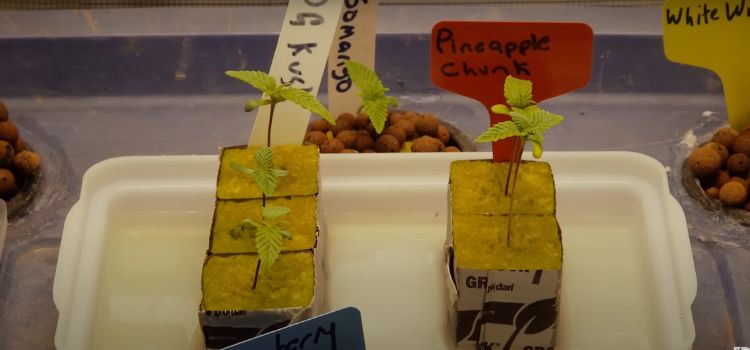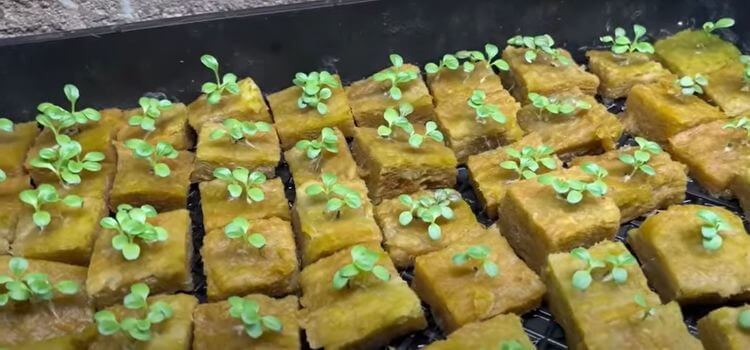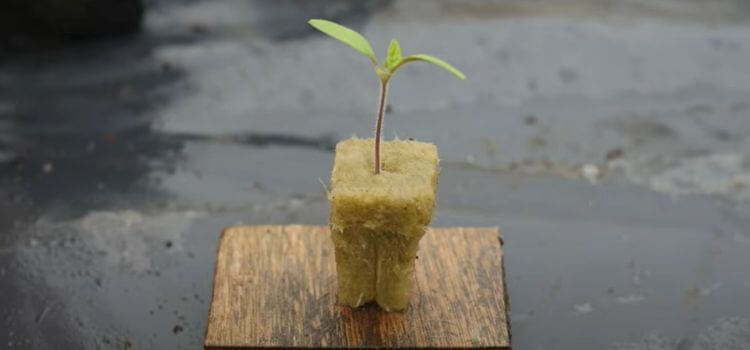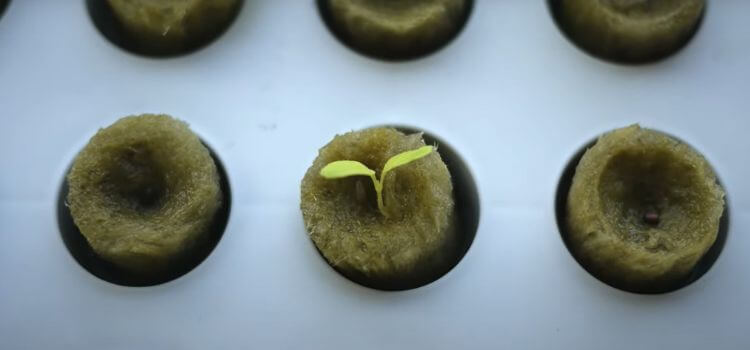As an Amazon Associate, I earn from qualifying purchases.
To germinate seeds for hydroponics using Rockwool, soak cubes for 30 minutes in pH-balanced water, then insert seeds. Ensure Rockwool stays moist and warm to promote germination.
Germinating seeds for a hydroponic system is a critical first step in cultivating a successful garden. Rockwool, a popular growing medium, is favoured for its ability to retain water and provide a stable environment for seedlings. This inert substance, made from molten rock spun into cotton candy-like fibers, is perfect for seed germination due to its sterile nature, which reduces the risk of disease.
Starting seeds in Rockwool involves pre-soaking the cubes to create a hospitable environment for the seeds. Controlling temperature and humidity is essential, as these factors greatly influence the germination process. With the right approach, Rockwool can help gardeners kickstart their hydroponic system with strong and healthy seedlings.
What Is Hydroponics And Rockwool?
Hydroponics is a soilless cultivation method using nutrient-rich water, ideal for controlled-environment agriculture. Rockwool, made from molten rock spun into fibers, serves as a stable, sterile medium for seed germination, ensuring optimal moisture and aeration for hydroponic systems.
What Is Hydroponics?
Hydroponics is a technique for growing plants without soil. In this system, plants are nourished by a water-based, nutrient-rich solution. Here’s why this method has gained popularity among gardeners and commercial growers:
- Water Efficiency: Plants in hydroponic systems use less water than soil-based gardening because the system recirculates water.
- Space Saving: Hydroponics allows for more plants per square foot as roots do not need to spread out in search of nutrients and water.
- Controlled Environment: Growers can precisely control nutrient levels, pH, and light exposure, leading to potentially faster growth and higher yields.
- Reduced Pests and Diseases: With no soil, there are fewer opportunities for soil-borne pests and diseases to attack the plants.

What Is Rockwool?
Rockwool is a popular growing medium used in hydroponics. It is made from molten rock that is spun into fibers and then formed into various shapes and sizes. Below are the attributes that make Rockwool a top choice for seed germination:
- Great Aeration: It allows for excellent oxygenation of the root zone, which is vital for healthy root development.
- Moisture Retention: Rockwool can retain water effectively, ensuring that seeds have a consistent supply of moisture without being waterlogged.
- PH Neutral: Typically, Rockwool is pH neutral, meaning it does not alter the pH balance of the nutrient solution.
- Reusable and Recyclable: After a thorough cleaning, Rockwool can be reused for new crops or recycled into other products, making it an environmentally conscious option.
Whether you’re a seasoned grower or a curious beginner, the synergy between these two elements provides an excellent foundation for your hydroponic endeavours.
Why Use Rockwool For Seed Germination In Hydroponics?
Rockwool, with its superb water retention and aeration properties, provides an optimal starting medium for seedlings in hydroponic systems. It ensures a sterile environment, promoting healthy root development and successful seed germination for hydroponics.
Optimal Water Retention And Aeration
Rockwool’s unique structure strikes a perfect balance between retaining moisture and allowing air to reach the seeds:
- Water retention: Rockwool fibers absorb an ideal amount of water, providing seeds with consistent moisture necessary for germination.
- Aeration: The fibrous texture ensures that air can circulate freely, supplying oxygen to the developing roots, which is crucial for healthy growth.
Sterile And Ph Neutral Environment
Choosing Rockwoil means giving your seeds a clean slate to start from:
Rockwool is sterile and devoid of pathogens that could otherwise harm vulnerable seedlings. It is free of any previous agricultural use that might have left harmful residues or disease-causing microbes.
Easy To Use And Transplant
The practicality of Rockwoil can’t be overstated:
- User-friendly: Preformed Rockwool cubes and slabs make it simple to sow seeds without the mess associated with soil.
- Transplant readiness: When seedlings are ready to move to their hydroponic system, Rockwoil’s stability allows for a smooth transition, minimizing transplant shock and root damage.
Consistent Seed Germination
Rockwool’s uniformity is critical to its success in germination:
The predictability of Rockwall offers an even playing field for all your seeds. Each cube provides the same conditions, which translates to uniform germination rates and growth stages. This consistency is invaluable for planning your crop cycles and ensuring that your plants progress together seamlessly.
Sustainability And Reusability
While there are environmental considerations to take into account, Rockwool does offer sustainable aspects:
- Longevity: Unlike soil and other organic media, Rockwool does not degrade over time, which means it can be reused for multiple growth cycles.
- Recyclability: Though it requires specific recycling facilities, Rockwall can be melted down and repurposed, reducing waste in the long term.

Materials Needed For Seed Germination In Rockwool
Embarking on hydroponic gardening requires specific materials for successful seed germination in Rockwool. Essential items include Rockwool cubes, a pH-balanced nutrient solution, and high-quality seeds, ensuring a robust start for your hydroponic plants.
Are you getting started with hydroponics? Germinating seeds using Rockwool is a fantastic way to ensure healthy plant growth right from the beginning.
Rockwool Cubes
Rockwool, made from molten rock spun into cotton candy-like fibers, is a popular medium for seed germination in hydroponics due to its superb water retention and aeration qualities. Ensure you purchase Rockwool cubes that are specifically designed for hydroponics. These cubes come in various sizes, so choose one that fits your system’s requirements.
Seedling Tray
To organize and maintain your Rockwool cubes, you’ll need a seedling tray:
- Purpose: Provides a stable base for your Rockwool cubes.
- Benefits: Helps maintain the moisture level and makes it easier to transport and handle the cubes.
Ph-adjusted Water
Rockwool naturally has a higher pH, which can influence nutrient uptake. To prepare for seeding:
- Adjustment necessity: Balance the pH of your water to around 5.5 to 6.5.
- Method: Use a pH meter and pH-adjusting chemicals to achieve the desired level.
Seeds
Select high-quality seeds that are suitable for hydroponic systems:
- Quality importance: Higher germination rates and better plant health.
- Variety choice: Depending on your hydroponic setup and what you intend to grow, choose seeds that thrive in a soilless environment.
Heat Mat (optional)
For enhancing germination rates, especially in more relaxed environments, consider using a heat mat:
- Function: Provides gentle warmth to the seedling tray and encourages faster germination.
- Use case: Handy for plants that require a warmer germinating environment.
Gathering these materials sets the stage for a successful hydroponic garden. Remember, the key is in the details, so ensure each component is suitable for your specific setup and plant choices.
Preparing Rockwool For Seed Germination
Master the art of hydroponic gardening by starting your seeds in Rockwool. Soak the Rockwool cubes in pH-balanced water, then gently insert seeds for optimal germination conditions.
The process is straightforward but requires attention to detail to create the perfect environment for your seeds to thrive.
Ph Balancing The Rockwool
Before introducing seeds to Rockwool, balancing its pH is necessary, as Rockwool naturally has a higher pH that can hinder seed growth. Here’s how you can adjust it:
- Soaking in pH-adjusted water: Immerse the Rockwool in water with a pH level of around 5.5, which is the ideal range for most plants.
- Duration of soaking: Leave the Rockwool submerged for at least an hour to ensure that the fibers absorb the adjusted water thoroughly.
- Rinsing: After soaking, gently rinse the Rockwool with the same pH-adjusted water to wash away any remaining alkaline residue.
Pre-sowing Seed Treatment
To maximize germination rates, seeds may require a pre-sowing treatment. Here’s what you can do to prepare your seeds for Rockwool:
- Seed selection: Choose high-quality, disease-free seeds to increase your chances of successful germination.
- Hydration: Gently hydrate your seeds by soaking them in water for a few hours to expedite the germination process.
- Disinfection: If needed, treat your seeds with a natural disinfectant solution to prevent fungal growth.
Planting Seeds In Rockwool
Once the Rockwool is pH balanced and the seeds are prepped, it’s time to plant. Here’s the best way to get your seeds into the Rockwool:
- Making indentations: Place your seeds in small indentations in the Rockwool. The depth should be around twice the size of the seed.
- Sowing: Carefully drop one or two seeds into each indentation. This ensures that at least one seed will germinate in each spot.
- Covering: Lightly cover the seeds with Rockwool or use a small piece of Rockwool to enclose the indentation.
Maintaining Moisture In Rockwool
Seeds need consistent moisture to germinate successfully. Here’s how to maintain the proper moisture levels in your Rockwool:
- Watering technique: Use a spray bottle to mist the Rockwool, keeping it moist but not waterlogged.
- Monitoring: Check the Rockwool daily to ensure it remains damp and mist as needed to maintain consistent moisture.
- Avoiding oversaturation: Overwatering can suffocate seeds, so be cautious not to let the Rockwoil become too wet.
By following these guidelines, you’ll create a nurturing environment that encourages your seeds to burst into life, setting a solid foundation for a thriving hydroponic garden. Remember, the key to healthy plants starts with the careful preparation of your germination medium.
Germinating Seeds In Rockwool
Germinating seeds in Rockwool simplifies the initial stages of hydroponic gardening. This inert, sterile medium provides excellent moisture control and airflow, promoting faster seedling growth. Just soak the cubes, plant the seeds, and maintain consistent moisture for successful germination.
Preparing Your Rockwool Cubes
Before sowing any seeds, it’s essential to ensure that your Rockwool cubes are ready to provide the best start for your future plants. Here’s how to prepare them:
- Soak the cubes: Submerge your Rockwool cubes in water with a pH level of around 5.5 to 6.0, which is optimal for most plant growth.
- Balance the pH: If necessary, adjust the water’s pH, using either pH up or down solutions, to create an ideal environment for your seeds.
- Saturate thoroughly: Allow the cubes to soak for at least an hour to ensure they’re evenly moistened, which will encourage uniform seed germination.
Planting Seeds In Rockwool
Planting your seeds in Rockwool is a straightforward process that promises a high germination rate when done correctly. Here’s the step-by-step guide:
- Create a small hole: Gently poke a hole in the center of the Rockwool cube, about a quarter-inch deep, to place the seed in.
- Insert the seed: Drop one or two seeds into the hole, ensuring they’re snug but not compressed, as seeds require space to expand.
- Cover gently: Lightly press the surrounding Rockwool over the hole to cover the seeds, which helps maintain the proper moisture levels and darkness for germination.
Maintaining Moisture And Warmth
After planting, maintaining the right conditions is critical for successful seed germination. Focus on these aspects:
- Keep the cubes moist: Regularly check your Rockwool cubes to ensure they remain damp, misting with water if they start to dry out.
- Provide warmth: Seeds need warmth to germinate, so aim to keep your growing area at a consistent temperature between 68°F to 72°F (20°C to 22°C).
Monitoring Germination Progress
Patience is essential as you wait for signs of life in your Rockwool cubes. Here’s what to look out for:
- Watch for sprouting: Depending on the plant species, sprouts should emerge from the Rockwool after a few days to a week.
- Check root development: Once the sprouts are visible, monitor the bottom of the cubes for root growth, indicating that it’s almost time to transfer to your hydroponic system.
Starting your hydroponic garden with Rockwool can set you on a path to lush, healthy plants.

Transplanting Germinated Seeds To Hydroponic System
Master the art of seed germination for your hydroponic garden using Rockwool, an efficient and clean medium. Transferring sprouted seeds into a hydroponic setup fosters robust growth, ensuring your plants thrive from the very beginning.
Preparing For Transplantation
Before moving your germinated seeds into the hydroponic system, it’s essential to ensure they’re ready for the transition. Seeds that have sprouted in Rockwool cubes must have developed a visible network of roots. This indicates that they can now absorb nutrients effectively from a water-based solution.
Steps For Transplanting Germinated Seeds:
Let’s dive into the process of transplanting your germinated seeds:
- Handle with care: Your seedlings’ roots are delicate. Gently remove the Rockwool cube from its container to avoid damaging the young roots.
- System compatibility: Check that the Rockwool cube size matches the hydroponic system’s grow baskets or holders. The cube should fit snugly but not be compressed.
- Watering the cube: Before placing the cube into the system, make sure it’s sufficiently moistened. This helps the seedling to adjust smoothly to its new environment.
- Placement in the system: Position the Rockwool cube in the center of the grow basket to ensure the plant remains upright and secure.
- Light exposure: Seedlings require ample light to continue growing. Position your hydroponic system in an area with sufficient lighting or add grow lights if necessary.
Aftercare For Transplanted Seedlings
Once the seedlings are comfortably situated in your hydroponic system, providing them with consistent care is crucial for their growth. Monitor water levels closely, as seedlings are prone to dehydration or overwatering. Additionally, begin introducing nutrients at a quarter of the strength recommended for mature plants, gradually increasing the concentration as they grow.
Common Mistakes To Avoid
- Overcrowding: Planting seedlings too close together can lead to competition for light and nutrients, stunting their growth.
- Ignoring pH levels: Hydroponic systems require careful monitoring of pH levels to ensure nutrient availability. Strive to maintain the pH within the optimal range for your plants.
- Neglecting hygiene: Keep your system clean to prevent the spread of diseases and pests. Regularly inspect your plants and promptly remove any that show signs of illness.
Frequently Asked Questions
Soak rockwool in pH-balanced water (5. 5-6. 5) for at least 30 minutes. Rinse thoroughly to remove any loose fibers or dust. Squeeze gently to expel excess water without compressing the cube. Place seeds or cuttings inside, ensuring a snug fit. Finally, place prepared rockwool in your hydroponic system.
Seeds may not germinate in rockwool due to incorrect moisture levels, unsuitable temperatures, poor seed quality, or inadequate light. Ensure proper conditions for successful germination.
Choosing between rockwool and soil for starting seeds depends on your needs. Rockwool provides excellent aeration and moisture control, ideal for hydroponic systems. Soil, on the other hand, is better for outdoor gardening and is more forgiving for beginners. Consider your growing setup and experience level when deciding.
Soak rock wool cubes in pH-balanced water for 15 to 30 minutes before planting seeds. This ensures proper moisture levels for seed germination.
Conclusion
Embarking on your hydroponic journey begins with the simple step of seed germination. Rockwool, with its superb water retention and aeration, sets the stage for robust plant growth. Remember, patience and precision in the early stages reward you with lush, healthy plants.

